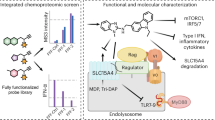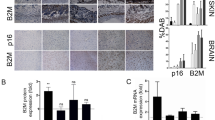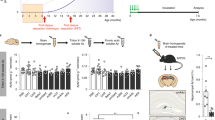Abstract
Amyloid is a term for extracellular protein fibril deposits that have characteristic tinctorial and structural properties. Heparan sulphate, or the heparan sulphate proteoglycan perlecan, has been identified in all amyloids and implicated in the earliest stages of inflammation-associated (AA) amyloid induction. Heparan sulphate interacts with the AA amyloid precursor and the β-peptide of Alzheimer's amyloid, imparting characteristic secondary and tertiary amyloid structural features. These observations suggest that molecules that interfere with this interaction may prevent or arrest amyloidogenesis. We synthesized low-molecular-weight (135–1,000) anionic sulphonate or sulphate compounds. When administered orally, these compounds substantially reduced murine splenic AA amyloid progression. They also interfered with heparan sulphate-stimulated β-peptide fibril aggregation in vitro.
This is a preview of subscription content, access via your institution
Access options
Subscribe to this journal
Receive 12 print issues and online access
$209.00 per year
only $17.42 per issue
Buy this article
- Purchase on Springer Link
- Instant access to full article PDF
Prices may be subject to local taxes which are calculated during checkout
Similar content being viewed by others
References
Young, I.D., Willmer, J.P., and Kisilevsky, R., The ultrastructural localization of sulphated proteoglycans is identical in the amyloids of Alzheimers disease and AA, AL, senile cardiac and medullary carcinoma-associated amyloidosis. Acta Neuropath. 78, 202–209, (1989).
Kisilevsky, R., Inflammation-associated amyloidogenesis-lessons for Alzheimers amyloidogenesis. Molec. Neurobiol. 8, 65–66, 1994.
Narindrasorasak, S., Altman, R.A., Gonzalez-DeWhitt, P., Greenberg, B.D., & Kisilevsky, R., An interaction between basement membrane and Alzheimer amyloid precursor proteins suggests a role in the pathogenesis of Alzheimer's disease. Lab. Invest. (in the press).
Kisilevsky, R., Lyon, A.W., & Young, I.D., A critical analysis of postulated pathogenetic mechanisms in amyloidogenesis. Crit. Rev. clin. Lab. Sci. 29, 59–82, (1992).
Tatsuta, E., Shirahama, T., Sipe, J.D., Skinner, M., & Cohen, A.S., Kinetics of SAP and SAA production by cultured mouse liver cells. Ann. N.Y., Acad. Sci. 389, 467–470, (1982).
Tatsuta, E., Sipe, J.D., Shirahama, T., Skinner, M., & Cohen, A.S., Different regulatory mechanisms for serum amyloid A and serum amyloid P by cultured mouse hepatocytes. J. biol. Chem. 258, 5414–5418, (1983).
Mackiewicz, A., Speroff, T., Ganapathi, M.K., & Kushner, I., Effects of cytokine combinations on acute phase protein production in two human hepatoma cell lines. J. Immun. 146, 3032–3037, (1991).
Ganapathi, M.K., Rzewnicki, D., Samols, D., Jiang, S.L., & Kushner, I., Effect of combinations of cytokines and hormones on synthesis of serum amyloid-A and C-reactive protein in HEP 3B-cells. J. Immun. 147, 1261–1265, (1991).
Brissette, L., Young, I., Narindrasorasak, S., Kisilevsky, R., & Deeley, R., Differential induction of the serum amyloid-A gene family in response to an inflammatory agent and to amyloid-enhancing factor. J. biol. Chem. 264, 19327–19332, (1989).
Sipe, J.D., Induction of the acute-phase serum protein SAA requires both RNA and protein synthesis. Br. J., exp. Path. B, 305–310, (1978).
McAdam, K.P.W.J., Elin, R.J., Sipe, J.D., & Wolff, S.M., Changes in human serum amyloid-A and C-reactive protein after etiocholanolone-induced inflammation. J. clin. Invest. 61, 390–394, (1978).
McAdam, K.P.W.J. & Sipe, J.D., Murine model for human secondary amyloidosis: genetic variability of the acute-phase serum protein SAA response to endotoxins and casein. J. exp. Med. 144, 1121–1127, (1976).
Axelrad, M.A., Kisilevsky, R., Willmer, J., Chen, S.J., & Skinner, M., Further characterization of amyloid enhancing factor. Lab.Invest. 47, 139–146, (1982).
Ganowiak, K., Hultman, P., Engstrom, U., Gustavsson, A., & Westermark, P., Fibrils from synthetic amyloid-related peptides enhance development of experimental AA-amyloidosis in mice. Biochem. biophys. Res. Commun. 199, 306–312, (1994).
Kisilevsky, R., & Boudreau, L., The kinetics of amyloid deposition: I. The effect of amyloid enhancing factor and splenectomy. Lab. Invest. 48, 53–59, (1983).
Deal, C.L., Sipe, J.D., Tatsuta, E., Skinner, M., & Cohen, A.S., The effect of amyloid enhancing factor (AEF) on the acute phase serum amyloid A (SAA) and serum amyloid P (SAP) response to silver nitrate. Ann. N.Y., Acad. Sci. 389, 439–441, (1982).
Lyon, A.W., et al. Co-deposition of basement membrane components during the induction of murine splenic AA amyloid. Lab. Invest. 64, 785–790, (1991).
Snow, A.D., & Kisilevsky, R., A close ultrastructural relationship between sulphated proteoglycans and AA amyloid fibrils. Lab. Invest. 57, 687–698, (1988).
Snow, A.D., Bramson, R., Mar, H., Wight, T.N., & Kisilevsky, R., A temporal and ultrastructural relationship between heparan sulphate proteoglycans and AA amyloid in experimental amyloidosis. J. Histochem. Cytochem. 39, 1321–1330, (1991).
Ailles, L., Kisilevsky, R., & Young, I.D., Induction of perlecan gene expression precedes amyloid formation during experimental murine AA amyloidogenesis. Lab. Invest. 69, 443–448, (1993).
Woodrow, S.I., Gore, J., Kisilevsky, R., & Young, I.D., Type IV collagen gene expression in experimental splenic AA amyloidosis. in Amyloid and Amyloidosis 1993 (eds Kisilevsky, R., et al.). 195-197 Park Ridge, New Jersey, (Parthenon Publishing Group, 1994).
McCubbin, W.D., Kay, C.M., Narindrasorasak, S., & Kisilevsky, R., Circular dichroism and fluorescence studies on two murine serum amyloid A proteins. Biochem. J. 256, 775–783, (1988).
Ancsin, J.B., & Kisilevsky, R., High affinity binding of laminin to serum amyloid A and the effect of entactin: Potential nucleation events in the genesis of inflammation-associated amyloid. Lab. Invest. 66, 106A, (1992).
De Beer, M.C., de Beer, F.C., McCubbin, W.D., Kay, C.M., & Kindy, M.S., Structural prerequisites for serum amyloid A fibril formation. J. biol. Chem. 268, 20606–206 12, (1993).
Narindrasorasak, S., et al. High affinity interactions between the Alzheimer's beta-amyloid precursor proteins and the basement membrane form of heparan sulphate proteoglycan. J. biol. Chem. 266, 12878–12883, (1991).
Snow, A.D., & Wight, T.N., Proteoglycans in the pathogenesis of Alzheimers disease and other amyloidoses. Neurobiol. Aging. 10, 481–497, (1989).
Fraser, P.E., Nguyen, J.T., Chin, D.T., & Kirschner, D.A., Effects of sulphate ions on Alzheimer-beta/A4 peptide assemblies—implications for amyloid fibrilproteoglycan interactions. J. Neurochem. 59, 1531–1540, (1992).
Leveugle, B., Scanameo, A., Ding, W., & Fillit, H., Binding of heparan sulphate glycosaminoglycan to beta- amyloid peptide: Inhibition by potentially therapeutic polysulphated compounds. NeuroReport. 5, 1389–1392, (1994).
Puchtler, H., Waldrop, F.S., & Meloan, S.N., Application of thiazole dyes to amyloid under conditions of direct cotton dyeing: correlation of histochemical and chemical data. Histochemistry. 77, 431–445, (1983).
Kagan, D.Z., & Rozinova, V.N., Inhibition of amyloidogenesis with Congo red in experimental amyloidosis. Problemy Tuberkuleza. 40, 72–74, (1974).
Caughey, B., & Raymond, G.J., Sulphated polyanion inhibition of scrapie-associated PrP accumulation in cultured cells. J. Virol. 67, 643–650, (1993).
Caughey, B., & Race, R.E., Potent inhibition of scrapie-associated PrP accumulation by Congo Red. J. Neurochem. 59, 768–771, (1992).
Caughey, B., Scrapie associated PrP accumulation and its prevention — insights from cell culture. Br. med. Bull. 49, 860–872, (1993).
Perlmutter, L.S., & Chui, H.C., Microangiopathy, the vascular basement membrane and Alzheimers disease — a review. Brain Res. Bull. 24, 677–686, (1990).
Perlmutter, L.S., Barron, E., Saperia, D., & Chui, H.C., Association between vascular basement membrane components and the lesions of Alzheimer's disease. J. Neurosci. Res. 30, 673–681, (1991).
Howard, J., & Pilkington, G.J., Antibodies to fibronectin bind to plaques and other structures in Alzheimer's disease and control brain. Neurosci. Lett. 118, 71–76, (1990).
Small, D.H., et al. Association and release of the amyloid protein precursor of Alzheimer's disease from chick brain extracellular matrix. J. Neurosci. 12, 4143–4150, (1992).
Narindrasorasak, S., et al. Characterization of high affinity binding between laminin and the Alzheimer's disease amyloid precursor proteins. Lab. Invest. 67, 643–652, (1992).
Young, I.D., Ailles, L., Narindrasorasak, S., Tan, R., & Kisilevsky, R., Localization of the basement membrane heparan sulphate proteoglycan in islet amyloid deposits in Type-II diabetes-mellitus. Arch. Path. lab. Med. 116, 951–954, (1992).
Author information
Authors and Affiliations
Rights and permissions
About this article
Cite this article
Kisilevsky, R., Lemieux, L., Fraser, P. et al. Arresting amyloidosis in vivo using small-molecule anionic sulphonates or sulphates: implications for Alzheimer's disease. Nat Med 1, 143–148 (1995). https://doi.org/10.1038/nm0295-143
Received:
Accepted:
Issue Date:
DOI: https://doi.org/10.1038/nm0295-143
This article is cited by
-
A self-destructive nanosweeper that captures and clears amyloid β-peptides
Nature Communications (2018)
-
Heparan sulfate S-domains and extracellular sulfatases (Sulfs): their possible roles in protein aggregation diseases
Glycoconjugate Journal (2018)
-
Sulfated glycosaminoglycans in protein aggregation diseases
Glycoconjugate Journal (2017)
-
Learning from Synthetic Models of Extracellular Matrix; Differential Binding of Wild Type and Amyloidogenic Human Apolipoprotein A-I to Hydrogels Formed from Molecules Having Charges Similar to Those Found in Natural GAGs
The Protein Journal (2017)
-
Systemic amyloidosis: a challenge for the rheumatologist
Nature Reviews Rheumatology (2010)



